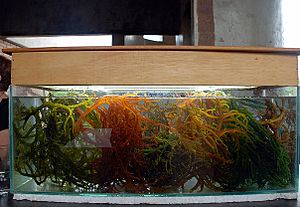Elkhorn sea moss facts for kids
Quick facts for kids Elkhorn sea moss |
|
|---|---|
 |
|
| Scientific classification | |
| Genus: |
Kappaphycus
|
| Species: |
alvarezii
|
Kappaphycus alvarezii, also known as elkhorn sea moss, is a type of red algae. This seaweed is very important because it is a main source of substances called carrageenans. Carrageenans are special gels that make things thicker or more stable. How this seaweed is grown affects the type of carrageenan that can be taken out of it.
Contents
What is Elkhorn Sea Moss?
This amazing alga can grow up to two meters (about 6.5 feet) long. It can be green or yellow in color. It grows incredibly fast! It can double its size in just 15 days.
What is Carrageenan?
Carrageenans are a group of natural substances. They come from certain types of red seaweed, like elkhorn sea moss. These substances are known for their ability to form gels and make liquids thicker. Different kinds of carrageenan have different properties. This means they can be used for many different things.
How is Carrageenan Used?
Carrageenans are used in many products we see every day. They help make things like frozen desserts, chocolate milk, and yogurt smooth and stable. You can also find them in whipped cream, instant foods, jellies, pet foods, and sauces. Beyond food, carrageenans are used in medicines, beauty products, and even in some industrial jobs like mining.
Extracting Carrageenan
There are two main ways to get carrageenan from this seaweed.
- Native extraction: The seaweed is mixed with water. The pure carrageenan is then separated from the rest.
- Alkaline-modified method: This way is cheaper and easier. The seaweed is mixed in a special liquid called an alkali solution. This leaves a mix of carrageenan and plant fibers. This mix is called "semirefined carrageenan."
Challenges for Elkhorn Sea Moss
Sometimes, K. alvarezii can get a disease called "ice-ice." This disease can greatly reduce how much carrageenan can be harvested from the seaweed.
An Unwanted Guest
Even though it's useful, this alga is an introduced species in Hawaii. This means it was brought there by people and is not naturally found there. In Hawaii, it is considered a noxious aquatic weed. This means it can harm the local environment and native species.

